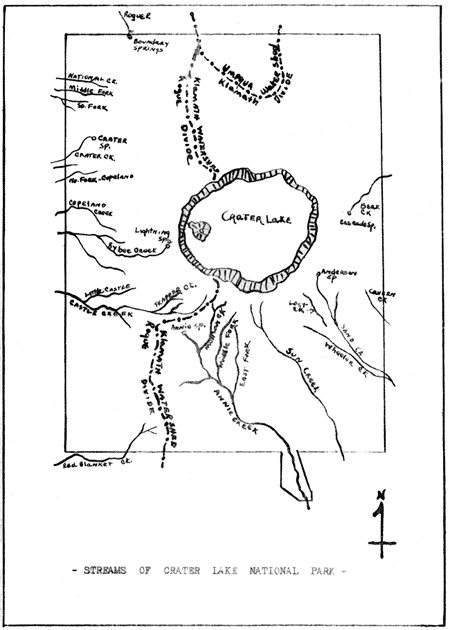Fish and Stream Survey
By O. L. Wallis, Ranger-Naturalist
A preliminary fish and steam survey has been conducted within Crater Lake National Park during this summer in an effort to gain a basis for scientific fish management of the streams within the area. From this work some interesting and enlightening information has been gleaned.
From the slops of Mount Mazama arise nearly a score of major streams and creeks. On the west the creeks drain into the Rogue watershed. Largest of these westward flowing streams are: The Rogue River, itself, which arises from Boundary Springs in the northern portion of the park: National, Crater, Copeland, Bybee, Castle, and Redblanket Creeks. The Klamath watershed eventually claims the waters flowing from the eastern slopes of the Cascade summit. Annie, Sun, and Sand Creeks and their tributaries form the largest streams of this drainage arising within the Park. Minor streams are Bear and Lost Creeks.
Most of the creeks arise from large, clear springs, the waters of which maintain a constant temperature of 36 to 38° F. From the springs, the streams run rapidly through deeply cut canyons carved out of the soft volcanic materials, and cascade over numerous lava flows in a series of falls. In some of these creeks the rapids are interspersed with numerous pools while in others the riffle area is nearly continuous throughout the course of the creek. The desirable ratio of riffles to pools, which is 50:50 or better, is lacking in most of the streams. Aquatic vegetation of moss and algae is common in most of the waters.
Aquatic insect life, the mainstay for food of the trout, is generally common although not in the great abundance which could be desired for an optimum condition. Bottom samples taken in each of the streams to determine the quantity and composition of the available food matter revealed that mayfly, stonefly, and caddis fly larvae, helegramites, round worms, and flat worms constitute most of this aquatic life.
The streams, for the most part, are well shaded with conifers, alders, or willow bushes. Submerged logs, large boulders, and overhanging banks furnish much shelter for the fish. The unstable bottoms, consisting as they do in some streams of pumice and cinders, is generally regarded as detrimental to fish life, especially to the eggs and fry.

(click on image for an enlargement in a new window)
Natural reproduction, a highly desirable factor in fish management, is generally lacking; but in Copeland, Bybee, Trapper, Munson, and Lost Creeks, the observation of fry and fingerlings indicate that some natural reproduction is taking place. In Copeland, Bybee, Trapper, and Lost Creeks, this is sufficient to produce enough to replenish the trout under only nominal fishing pressure. In all other streams, if fishing is to be maintained, a limited amount of planting varying according to the qualities of food and other factors of each stream is necessary.
Since 1931, 743,949 fingerlings (275,564 rainbow and 467,385) eastern brook trout) have been planted in the streams. The last plantings were made in 1940 when 66,350 eastern brook and 30,914 rainbow fingerlings were stocked. Fish planting is an expensive operation. The abundance of fish in a stream at present is not in direct proportion to the numbers planted in that creek. Into Annie Creek, one of the most accessible, were dumped 20,758 eastern brook fingerlings, 31% of all eastern brook planted in 1940, and yet this stream still maintains the reputation of being one of the poorest fishing streams within the area.
Four species of trout were collected; these were, in order of greatest numbers: eastern brook trout, Salvelinus fontinalis (Mitchell), Dolly Varden, Salvelinus malma spectabilis,rainbow trout Salmo gairdnerii gairdnerii (Richardson), and German Brown or Loch Leven trout, Salmo trutta Linnaeus. It is interesting to find a large Loch Leven in Sand Creek, Dolly Vardens and rainbows in Sun Creek, for in these streams only eastern brook have been planted according to park records. Fifteen hundred rainbows were planted in Munson Creek in 1937; only one rainbow has been reported caught from this stream in the past two seasons. More rainbow than eastern brook trout have been planted in the streams of the Rogue drainage, but only three rainbows were collected. It would seem from this that the eastern brook trout is better adapted to the cold, clear, high-montane streams than the rainbow. The temperatures of these waters vary from 38 to 49 degrees F.

